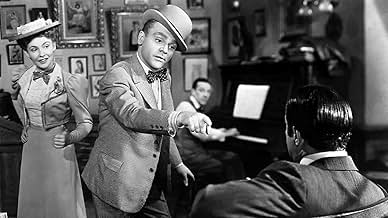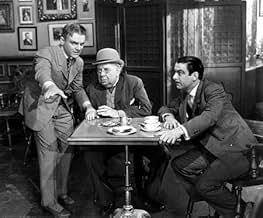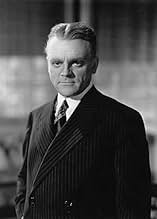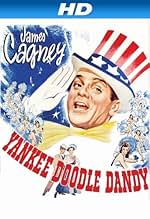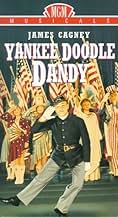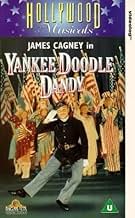AVALIAÇÃO DA IMDb
7,6/10
18 mil
SUA AVALIAÇÃO
A vida do renomado compositor musical, dramaturgo, ator, dançarino e cantor George M. Cohan.A vida do renomado compositor musical, dramaturgo, ator, dançarino e cantor George M. Cohan.A vida do renomado compositor musical, dramaturgo, ator, dançarino e cantor George M. Cohan.
- Direção
- Roteiristas
- Artistas
- Ganhou 3 Oscars
- 9 vitórias e 6 indicações no total
Patsy Parsons
- Josie Cohan - As a Girl of 12
- (as Patsy Lee Parsons)
Avaliações em destaque
So it takes liberties with facts. So it's jingoistic. Big deal! I adore it for its depiction of turn-of-the-(20th}century New York, especially its theater, which has fascinated me for years. And it has the breath-taking performance of Jimmy Cagney in the title role; he's absolutely elecrifying in the musical numbers. If some scenes are mawkish, well, I think that can be forgiven.
This movie, above all others, make me so proud to be an American.
This movie, above all others, make me so proud to be an American.
I have seen this film several times--including just recently. However, somehow I forgot to review the movie--and I noticed this today.
This is a difficult film to rate, as it's so unique. After all, seeing Jimmy Cagney in the lead is a bit surreal. You don't expect to see this tough-guy performing as a hoofer. You also don't expect to see his style of tap dancing. It is NOTHING like Fred Astaire--full of grace and style. Instead, it's pure energy and is, at times, a bit gangly. Now this isn't to say it's bad--it just isn't subtle as Cagney throws EVERYTHING into the dances. His tapping is a bit more like stomping---but, it is still a marvel to watch.
The film is a VERY Hollywoodized version of the life of the writer/performer George M. Cohan. Much of the guy's life is in the film but also much of the film is pure fiction meant to entertain. This is VERY typical of a film of this era. However, despite the style of dance and liberties the film takes, it is also incredibly entertaining and fun--filled with unabashed patriotism and spirit. Well worth seeing.
This is a difficult film to rate, as it's so unique. After all, seeing Jimmy Cagney in the lead is a bit surreal. You don't expect to see this tough-guy performing as a hoofer. You also don't expect to see his style of tap dancing. It is NOTHING like Fred Astaire--full of grace and style. Instead, it's pure energy and is, at times, a bit gangly. Now this isn't to say it's bad--it just isn't subtle as Cagney throws EVERYTHING into the dances. His tapping is a bit more like stomping---but, it is still a marvel to watch.
The film is a VERY Hollywoodized version of the life of the writer/performer George M. Cohan. Much of the guy's life is in the film but also much of the film is pure fiction meant to entertain. This is VERY typical of a film of this era. However, despite the style of dance and liberties the film takes, it is also incredibly entertaining and fun--filled with unabashed patriotism and spirit. Well worth seeing.
The amazing piece of timing here is when Warner Bros. began work on this biography of entertainer George M. Cohan, WWII had not yet broken out. The attack on Pearl Harbor occurred the day before shooting began. When the film opened people on the home front badly needed some morale boosting, and this film gave it to them. It's just a joyous musical costume piece from start to finish with nice comic touches balanced with some sentimental moments (supposedly Walter Huston's deathbed scene had even taskmaster director Michael Curtiz crying). There's nothing in the way of real conflict or even much heavy in the way of romance between Cohan and his fictitious film wife "Mary", who was modeled after Cohan's actual second wife in some ways. Cohan was actually married twice. Oddly enough, it was Cohan who said he wanted as little romance in the film as possible.
The more I learn about Cohan the more I realize that Cagney was perfect to play him - both Irish Americans, both about the same size and build, and George Cohan's style of dancing and singing were about the same as Cagney's. It's hard to believe that Fred Astaire was Cohan's first choice to play himself. Astaire was a great talent, but I don't think he could have conveyed the combination of mischief, optimism and energy that was Cohan the way that Cagney ultimately did. Several people criticize Cagney's dancing here, but that eccentric style was Cohan's, who always considered himself more of an overall entertainer than a dancer in the first place.
If you're "date conscious" as I am, there are some matters of plot that might bother you. Cohan was born on July 2 or 3, not July 4. Cohan's mother outlived his father by eleven years and Cohan's father was not "very old" when he died as is said in the film - at least by today's standards. When Cohan's father died in 1917, he was only 69. Cohan's sister did die young - she was only 39, dying in 1916, plus she was not his little sister. Instead Josie was a year older than George. The film has Josie marrying when she would have been close to forty, when she actually married at the beginning of the 20th century and thus was the one to break up the four Cohans, not George. Also, Cohan received his Congressional Medal in 1936, not as WWII began as shown in the film. However the plot device of having George M. recount his life story to FDR, receiving his Congressional medal in the Oval Office, and then dance joyously down the White House stairs and into the streets joining a group of marching soldiers in a chorus of "Over There" was probably a great way to bridge Cohan's patriotic past with what was then an uncertain time that certainly needed a dose of his optimism.
The one thing that I did find a little odd - and one thing isn't much in a two plus hour long movie - is that it is hard to spot the actual point in the film where Mary becomes George's wife. There is quite a bit of domesticity shown before the two were married. Mary is cooking for George, staying in his apartment alone waiting for him to come home from the show, and acting very much like they are already married. The only way you know they are not is that George very subtly pops the question to the point that I'm surprised even Mary knew what he was asking! I know this doesn't seem like much in today's world, but considering that they were trying to paint Cohan in the most positive light possible and that the living arrangements might be misunderstood, I am surprised that the censors of that time never raised the issue.
At any rate, I highly recommend this one. You'll have a great time, at least in part because you can see that Cagney is having a great time. He always said this film was his favorite, and it shows in his performance.
The more I learn about Cohan the more I realize that Cagney was perfect to play him - both Irish Americans, both about the same size and build, and George Cohan's style of dancing and singing were about the same as Cagney's. It's hard to believe that Fred Astaire was Cohan's first choice to play himself. Astaire was a great talent, but I don't think he could have conveyed the combination of mischief, optimism and energy that was Cohan the way that Cagney ultimately did. Several people criticize Cagney's dancing here, but that eccentric style was Cohan's, who always considered himself more of an overall entertainer than a dancer in the first place.
If you're "date conscious" as I am, there are some matters of plot that might bother you. Cohan was born on July 2 or 3, not July 4. Cohan's mother outlived his father by eleven years and Cohan's father was not "very old" when he died as is said in the film - at least by today's standards. When Cohan's father died in 1917, he was only 69. Cohan's sister did die young - she was only 39, dying in 1916, plus she was not his little sister. Instead Josie was a year older than George. The film has Josie marrying when she would have been close to forty, when she actually married at the beginning of the 20th century and thus was the one to break up the four Cohans, not George. Also, Cohan received his Congressional Medal in 1936, not as WWII began as shown in the film. However the plot device of having George M. recount his life story to FDR, receiving his Congressional medal in the Oval Office, and then dance joyously down the White House stairs and into the streets joining a group of marching soldiers in a chorus of "Over There" was probably a great way to bridge Cohan's patriotic past with what was then an uncertain time that certainly needed a dose of his optimism.
The one thing that I did find a little odd - and one thing isn't much in a two plus hour long movie - is that it is hard to spot the actual point in the film where Mary becomes George's wife. There is quite a bit of domesticity shown before the two were married. Mary is cooking for George, staying in his apartment alone waiting for him to come home from the show, and acting very much like they are already married. The only way you know they are not is that George very subtly pops the question to the point that I'm surprised even Mary knew what he was asking! I know this doesn't seem like much in today's world, but considering that they were trying to paint Cohan in the most positive light possible and that the living arrangements might be misunderstood, I am surprised that the censors of that time never raised the issue.
At any rate, I highly recommend this one. You'll have a great time, at least in part because you can see that Cagney is having a great time. He always said this film was his favorite, and it shows in his performance.
`Yankee Doodle Dandy' makes the viewer say, `They don't make them like that anymore.' The film is uplifting for its espousal of unabashed patriotism and its representation of America as a place in which a gifted performer like George M. Cohan could rise from vaudeville to Broadway. It is also moving for its reverence for the nineteenth late century theatre and early twentieth century Broadway: the sequence showing Cohan's successes of the 1920s commemorate the other musical and non musical hits of the decade as much as Cohan's. I was moved to tears by the ending showing the elderly Cohan joining in a World War II parade, a group of soldiers marching to `Over There' and being asked why he isn't singing, `Hey old-timer, don't you know this song?' `Yankee Doodle Dandy' is a celebration of Cohan's life and career -- a little sanitised perhaps, but still portraying his love for his family, his profession and his country. It isn't a museum piece but more of a picture from another era and in a time when America is honoured by songs such as `Kick Ass USA' it's a valuable reminder of an age when people feeling their country under threat roused their nationalism by reminding themselves of what made them want to fight for it.
James Cagney won his only Oscar for his recreation of George M. Cohgan in Yankee Doodle Dandy. Already terminally ill, Cohan lived long enough to see the film and no doubt he would have approved of it because it sure is how he would like to have been remembered.
In 1942 when Yankee Doodle Dandy premiered there was a whole generations of people left alive who saw George M. Cohan perform. Watching the film today Cohan is like a figure from antiquity. But Warner Brothers was lucky to have James Cagney with the studio who's dancing style closely paralleled Cohan's. If it is ever run on Turner Classic Movies, make sure you see George M. Cohan's sound film The Phantom President. You will be astonished to see how closely Cagney captured his style. In the same way that Philip Seymour Hoffman captured Truman Capote and Joaquin Phoenix became Johnny Cash.
Cohan's contemporaries are also like names from antiquity. But a century ago when Cohan was just hitting the big time performers like Fay Templeton, Nora Bayes, and Eddie Foy were very big stars and in 1942 plenty of people saw them also. I wish we had some film of them to see how Irene Manning, Frances Langford, and Eddie Foy, Jr. did in their recreations. I'm sure Foy, Jr. did a smashing job with his Dad.
The background stuff is true enough. Cohan was born to a pair of vaudeville performers Jerry and Nellie Cohan played here by Walter Huston and Rosemary DeCamp. Later on a sister was added to the Cohan family and here Josie Cohan is played by Jeanne Cagney. They did do all the towns, big and small, in America. Cagney meets wife Joan Leslie at Shea's Theater in Buffalo, New York and Shea's survives to this day. And his first real success was Little Johnny Jones which score included American classics, Yankee Doodle Dandy and Give My Regards to Broadway.
What's left out is the fact Cohan had two wives. His second wife survived him and died in the early Seventies. As his songs became popular in patriotic/rightwing circles, Cohan's personal politics reflected that. He fought hard and lost in the battle for Actors Equity. Cohan thought a union of players was tantamount to Communism. But such was his standing among performers that Cohan was granted the unique privilege of being allowed to appear on stage without having to join Equity once the union was recognized as the bargaining agent for players.
Cohan is shown in Yankee Doodle Dandy as gracefully having retired when other trends in popular music took over. Far from it, he was a very bitter man and when he did that final comeback in I'd Rather Be Right he fought with Kaufman and Hart over the book and Rodgers and Hart over the songs.
But Yankee Doodle Dandy presents the public musical face of George M. Cohan and does it very well. To this day, some forty years after first seeing Yankee Doodle Dandy on television, I love the recreations of Yankee Doodle Dandy, Give My Regards to Broadway, and You're a Grand Old Flag as they were first seen on stage. Plus some of the snatches of the lesser known Cohan songs as performed by the players portraying the Cohan family and others.
When all is said and done, George M. Cohan was a great force of nature in the American musical theater. And we thank his father, mother, and sister, and George M. himself for what he left us.
In 1942 when Yankee Doodle Dandy premiered there was a whole generations of people left alive who saw George M. Cohan perform. Watching the film today Cohan is like a figure from antiquity. But Warner Brothers was lucky to have James Cagney with the studio who's dancing style closely paralleled Cohan's. If it is ever run on Turner Classic Movies, make sure you see George M. Cohan's sound film The Phantom President. You will be astonished to see how closely Cagney captured his style. In the same way that Philip Seymour Hoffman captured Truman Capote and Joaquin Phoenix became Johnny Cash.
Cohan's contemporaries are also like names from antiquity. But a century ago when Cohan was just hitting the big time performers like Fay Templeton, Nora Bayes, and Eddie Foy were very big stars and in 1942 plenty of people saw them also. I wish we had some film of them to see how Irene Manning, Frances Langford, and Eddie Foy, Jr. did in their recreations. I'm sure Foy, Jr. did a smashing job with his Dad.
The background stuff is true enough. Cohan was born to a pair of vaudeville performers Jerry and Nellie Cohan played here by Walter Huston and Rosemary DeCamp. Later on a sister was added to the Cohan family and here Josie Cohan is played by Jeanne Cagney. They did do all the towns, big and small, in America. Cagney meets wife Joan Leslie at Shea's Theater in Buffalo, New York and Shea's survives to this day. And his first real success was Little Johnny Jones which score included American classics, Yankee Doodle Dandy and Give My Regards to Broadway.
What's left out is the fact Cohan had two wives. His second wife survived him and died in the early Seventies. As his songs became popular in patriotic/rightwing circles, Cohan's personal politics reflected that. He fought hard and lost in the battle for Actors Equity. Cohan thought a union of players was tantamount to Communism. But such was his standing among performers that Cohan was granted the unique privilege of being allowed to appear on stage without having to join Equity once the union was recognized as the bargaining agent for players.
Cohan is shown in Yankee Doodle Dandy as gracefully having retired when other trends in popular music took over. Far from it, he was a very bitter man and when he did that final comeback in I'd Rather Be Right he fought with Kaufman and Hart over the book and Rodgers and Hart over the songs.
But Yankee Doodle Dandy presents the public musical face of George M. Cohan and does it very well. To this day, some forty years after first seeing Yankee Doodle Dandy on television, I love the recreations of Yankee Doodle Dandy, Give My Regards to Broadway, and You're a Grand Old Flag as they were first seen on stage. Plus some of the snatches of the lesser known Cohan songs as performed by the players portraying the Cohan family and others.
When all is said and done, George M. Cohan was a great force of nature in the American musical theater. And we thank his father, mother, and sister, and George M. himself for what he left us.
Você sabia?
- CuriosidadesMany facts were changed or ignored to add to the feel of the movie. For example, the real George M. Cohan was married twice, and although his second wife's middle name was Mary, she went by her first name, Agnes. In fact, the movie deviated from the truth to such a degree that Cohan's daughter Georgette commented, "That's the kind of life Daddy would have liked to have lived."
- Erros de gravaçãoThe "You're A Grand Old Flag" number, supposedly takes place in the 1906 production of "George Washington Jr.," and uses multiple period flags to represent times before 1906. The Civil War flag, as an example, is correct for the time in question. However, in the final sequence characters carry, and an soft screen projection is made of, multiple 48 star flags. The 48 star flag was not introduced until 1912. In 1906, it should have been a 45 star flag. (Oklahoma was admitted to the Union in 1907, New Mexico and Arizona in 1912).
- Citações
George M. Cohan: My mother thanks you, my father thanks you, my sister thanks you, and I thank you.
- Versões alternativasAlso available in a computer colorized version.
- ConexõesFeatured in The Voice That Thrilled the World (1943)
- Trilhas sonorasThe Yankee Doodle Boy
(1904) (uncredited)
from the Broadway Show "Little Johnny Jones"
Written by George M. Cohan
Played during the opening credits
Sung and Danced by James Cagney and Chorus
Principais escolhas
Faça login para avaliar e ver a lista de recomendações personalizadas
- How long is Yankee Doodle Dandy?Fornecido pela Alexa
Detalhes
- Data de lançamento
- País de origem
- Idioma
- Também conhecido como
- Canção da Vitória
- Locações de filme
- Empresa de produção
- Consulte mais créditos da empresa na IMDbPro
Bilheteria
- Faturamento bruto nos EUA e Canadá
- US$ 11.800.000
- Tempo de duração2 horas 6 minutos
- Cor
- Proporção
- 1.37 : 1
Contribua para esta página
Sugerir uma alteração ou adicionar conteúdo ausente




